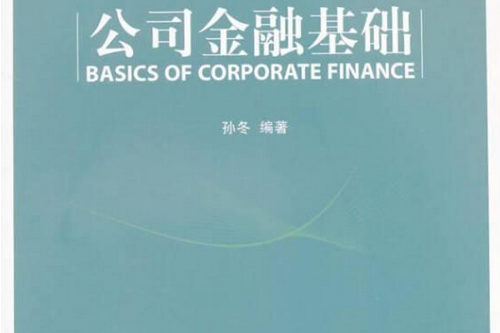《公司金融基礎》是2015年9月對外經濟貿易大學出版社出版的書籍,作者是孫冬。
基本介紹
- 書名:公司金融基礎
- 作者:孫 冬
- 出版社:對外經濟貿易大學出版社
- 出版時間:2015年9月
- 定價:35 元
- 開本:185mm×260mm
- ISBN:9787566314352
- 版次/印次:1/1
- 字數:323千字

《公司金融基礎》是2015年9月對外經濟貿易大學出版社出版的書籍,作者是孫冬。
金融基礎設施是指金融運行的硬體設施和制度安排,主要包括支付體系、法律環境、公司治理、會計準則、信用環境、反洗錢以及由金融監管、中央銀行最後貸款人職能、投資者保護制度組成的金融安全網等。作用 金融基礎設施的一個重要功能是能夠有效...
一般而言,企業的“財務”或“理財”是以現金收支為主的企業資金收支活動的總稱,是建立在企業的會計信息基礎上加以管理的。而公司金融所研究的內容要比此龐大得多。一是它不再局限於企業內部,因為現代公司的生存和發展都離不開金融系統...
該課程共七個模組,包括金融和金融系統、跨時期最佳化:時間價值與折現現金流分析、資產估值:一價定律、債券與股票估值、風險管理概述:概念與原理、投資組合理論與資本資產定價模型、金融衍生品:期貨與期權、公司金融基礎。課程性質 課程定位...
《金融基礎》是2009年科學出版社出版的圖書,可作為中等職業學校金融事務專業教學用書,也可作為財經類專業的教學參考用書,還可作為金融企業人員的技術培訓用書。 內容簡介 《金融基礎》較全面地敘述了貨幣、金融的產生與發展、職能及作用,...
《金融基礎知識(第3版)》是2023年1月人民郵電出版社出版的圖書,作者是韓宗英。內容簡介 本書系作者多年金融工作和教學工作經驗的結晶。本書主要以貨幣、信用、銀行為三條主線,將金融理論和實際操作知識融入到貨幣與貨幣制度、信用與...
《金融基礎(第二版)(金融事務專業)》是2009年高等教育出版社出版的圖書,作者是陳利榮。內容簡介 《金融基礎(第二版)(金融事務專業)》是中等職業教育金融事務專業國家規劃教材《金融基礎》的第二版,是在第一版教材的基礎上根據...
《金融基礎》是2020年機械工業出版社出版的圖書。本書根據高職高專人才培養要求,結合編者多年的教學經驗,對金融基礎知識進行了全面、系統的介紹。本書的主要內容包括貨幣與貨幣制度、信用、利息與利率、金融工具、金融機構體系、銀行業務、...
金融基礎 《金融基礎》是2017年格致出版社 出版的圖書。
本書針對高等職業院校金融入門課程的特點,將內容龐雜的金融基礎知識體系系統地呈現出來,力求做到理論知識必需、夠用,體系科學、規範,幫助學生為今後從事金融類工作及取得金融類證書打下基礎。第二,內容求新,突出套用性。本書從高等職業...
《金融基礎》是2017年北京理工大學出版社出版的圖書。金融基礎是財經類專業的專業基礎課程,按照“ 以就業為導向,以能力為本位”的原則,王惠凌、廖颻霏主編的《金融基礎》從金融行業實際工作入手,分十一章闡述了金融基礎的理論知識:...
資金向企業的轉移 投資銀行家的作用 暫擱註冊 向公眾新發行企業有價證券的規章制度 2002年《薩班斯奧克斯利法案》小結 目的回顧 網上作業 金融學基礎——金融機構、投資和管理導論(第10版)目錄 第4章有價證券市場 做市商 綜合交易...
《金融基礎》是2019年中國人民大學出版社出版的圖書。內容簡介 本書詳細介紹了金融學基礎知識,包括貨幣制度、信用、金融市場、金融機構、中央銀行和商業銀行、金融監管、貨幣需求與貨幣供應、通貨膨脹與通貨緊縮及其治理,以及國際金融等內容...
金融基礎知識(第八版)《金融基礎知識(第八版)》,2020年12月8日,被教育部辦公廳公布為“十三五”職業教育國家規劃教材。
《南開大學金融學本科系列教材:公司金融學》是2009年廈門大學出版社出版的圖書,作者是閻大穎。內容簡介 《南開大學金融學本科系列教材:公司金融學》主要涵蓋了公司金融基礎、公司金融決策和公司金融專題三個方面。公司金融基礎部分將對公司...
《金融基礎(第2版)》是一本2019年人民郵電出版社出版的圖書,作者是岳高社,董雷光 ,共分十一章,全面、系統、科學、準確地闡述了貨幣、信用、金融機構、金融市場、貨幣供求、貨幣均衡與貨幣政策、國際金融以及金融危機與金融監管等基礎...
《金融基礎知識》是2015年01月人民郵電出版社出版的圖書,作者是韓宗英、王瑋薇。編輯推薦 較第1版降低貨幣制度、商業銀行產生等內容的比重,增加金融普及知識和證券、保險、信託等實用性內容比重,強化案例在教學中的使用。由完整金融故事...
《金融基礎(第二版)》是2013年8月中國人民大學出版社出版的圖書,作者是張偉芹。內容簡介 本書詳細介紹了金融學基礎知識,包括貨幣制度、信用、金融市場、金融機構、中央銀行和商業銀行、金融監管、貨幣需求與貨幣供應、通貨膨脹與通貨...
金融基礎知識 《金融基礎知識》是2019年中國財政經濟出版社出 版的圖書。
(十) 國務院金融管理部門規定的其他事項。第十五條【公布名單】國務院金融管理部門依法公布金融基礎設施及運營機構名單。第三章 運營要求 第十六條【公司治理】金融基礎設施運營機構應當建立健全清晰、透明的治理結構和有效的問責機制,並...
《新編金融基礎(第3版)》是2019年8月人民郵電出版社出版的圖書,作者是南旭光。內容簡介 本書全面闡述了現代貨幣金融基礎性理論及實務知識,根據易於讀者接受的邏輯順序,將主要內容設定為現代金融總論:思考與透視;貨幣及其制度:歷史與...
《金融基礎知識(第6版)》是2010年中國財政經濟出版社出版的圖書。本書系統而簡明地介紹了金融的基本知識、基本業務與基本技能。內容簡介 《金融基礎知識(第6版)》內容簡介:“金融基礎”是財經類專業基礎課程。全書圍繞中等職業教育以...
